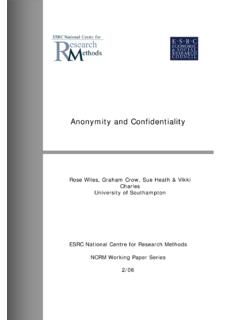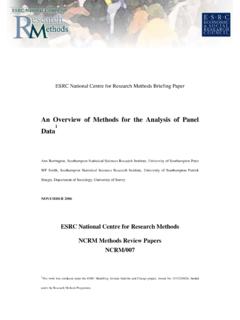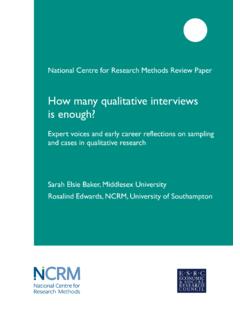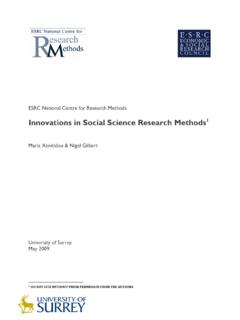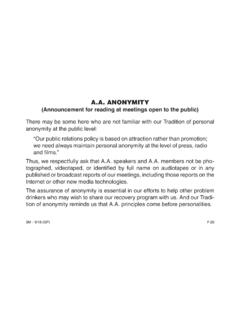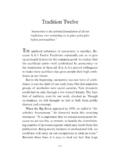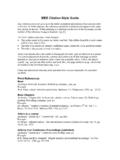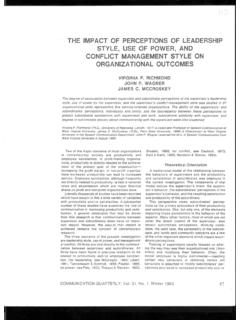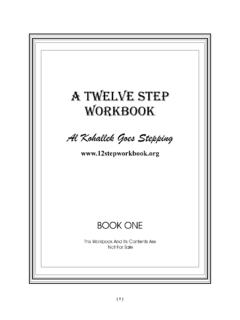Transcription of Managing anonymity and confidentiality in social …
1 Managing anonymity and confidentiality in social research: the case of visual data in Community research ESRC National Centre for Research Methods NCRM Working Paper Series 8/08 Graham Crow and Rose Wiles Abstract anonymity and confidentiality of participants are central to ethical research practice in social research. Where possible, researchers aim to assure participants that every effort will be made to ensure that the data they provide can not be traced back to them in reports, presentations and other forms of dissemination.
2 The primary method researchers use to preserve anonymity and confidentiality is the use of pseudonyms for participants and also for the location of the research. In addition, other practices, such as changing the reported characteristics of participants (such as gender or occupation) are also used by some researchers to conceal identities and thereby maintain the confidentiality of the data provided by participants. There are several issues that such practices raise. One is that it is difficult for researchers to know how far to take anonymisation of individuals in order for them not to be identifiable, given that research findings may be presented to a variety of audiences, including members of participants communities.
3 A second issue is that research participants hold differing views about the desirability of anonymisation, presenting researchers with difficult choices between respecting the preferences of those participants who wish to be identifiable and those who prefer to remain anonymous. A third issue is that of whether or not to attempt the anonymisation of the location of the research, which may be adjudged more or less practical or impractical (depending on its distinctiveness) and more or less desirable (depending on its importance in providing the social context of the analysis that is being developed). This paper explores these issues by looking at how they have been handled by researchers in the field of community sociology (broadly defined) who have used visual data in their reports.
4 This analysis allows the argument to be developed that although the issues themselves are not new, the ways in which they are handled by researchers are necessarily evolving in the context of technological change, the growth of research regulation, and shifts in the expectations of research that participants hold. Introduction A recent PhD thesis (Boyce 2006) which reports on research conducted in a UK community where high-profile anti-paedophile demonstrations had taken place not long previously provides an instructive case to begin consideration of the issues with which this paper is concerned. Although the demonstrations had been national (and even international) news, the community is referred throughout the thesis as Stanley , a pseudonym.
5 The thesis includes a number of photographs, although nearly all of these are of places but not of people. The only pictures that do include people are two of the local carnival (in which people s costumes prevent identification), and one from a long time ago, of two children playing on the estate in the 1940 s when it was first built. The community is anonymised and yet knowable by anyone who remembers recent news stories, and the views of its residents who took part in the study are afforded confidentiality but without completely allaying concerns about the possibility of their being identifiable by knowledgeable community insiders.
6 Community studies have a long record of photographs being included to help to convey the sense of place of the community being studied (Crow 2000). This is one of their strengths given that, as Geoff Payne points out, humans see as well as hear and think. If the locality is relevant, then it is even more important than in other walks of sociology to see what it looks like (1996: 19, emphasis in original). Visual methods do raise a number of methodological challenges, however. According to Caroline Knowles and Paul Sweetman, the problem of ascribing anonymity or confidentiality to research subjects who have been photographed is among the more mundane considerations (2004: 12) that this approach requires researchers to address, but the fact that these are routine matters should not lead to their being treated as unimportant.
7 As Victoria Alexander points out, the confidentiality of the subjects of photographs requires more of the researcher than that they just change the It is legal to photograph structures, objects and people in public settings, but people can object, sometimes violently (2001: 353). This discussion is an expression of the fundamental issue addressed by Pierre Bourdieu at the beginning of The Weight of the World where he reflects on the anxiety that researchers necessarily feel about the process of putting something that is private into the public domain. In that particular study, Bourdieu and his colleagues sought to protect their participants by changing the names of places and individuals to prevent [and] to protect them, from the dangers of misinterpretation (1999: 1).
8 Arguably the vividness of the descriptions provided by Bourdieu and his co-authors provides an alternative means by which readers can visualise the nature of place and people being discussed, but other studies continue the tradition of including photographs, and the ways in which their authors deal with these issues are worth considering in more detail. Anonymisation: how far to take it? The risk of the anonymisation process in research being compromised can be reduced by the exclusion of visual material from research reports, or by the inclusion of visual material in which no research participants figure.
9 The study of four residential areas in and around Manchester (UK) by Mike Savage and his colleagues identifies the areas but gives pseudonyms to the 182 research participants drawn from those four areas. The main report on this research, Globalization and Belonging (Savage et al 2005), contains no photographs, although Savage does include photographs of the four areas in a separate discussion of the research (Savage 2002: 63). Interestingly for our discussion here, these photographs contain houses and gardens, roads and vehicles but no people. This is one response to the important ethical consideration relating to photographs of communities, that agreement for visual images to be used for research purposes is hard to secure from all members of a crowd.
10 As Geoff and Judy Payne put it, Complete informed consent virtually impossible in a busy street or other public place (2004: 239). A rather different line is followed by Janet Foster in her study of change in the east end of London (UK), Docklands. This monograph contains 60 photographs, many by the author. She starts the book with an account of how she had been prompted to undertake the research by the visual impact that the redevelopment of the area had had on her when interviewing (for a previous project) a woman whose flat had panoramic views of the locality (1999: 1). What is striking about the photographs in Docklands is that those dating back to the early 20th century that were drawn from archives portray streets and other public places full of people, in contrast to those taken during the fieldwork period which very rarely feature anyone.
